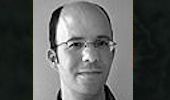The Physics & Astronomy Colloquium Series presents Adam Lidz of the University of Pennsylvania on “The First Luminous Objects and the Epoch of Reionization” on Friday, Sept. 5, at 4:10 p.m. in Walter 245.
Abstract: An exciting and largely unexplored frontier in observational and theoretical cosmology is to understand the properties of the universe between 400,000 years and one billion years after the big bang. Notably, the first galaxies formed in this time period, perhaps a few hundred million years after the big bang. These galaxies strongly influenced the gas in their surroundings as well as the formation of subsequent generations of galaxies. The early galaxies emitted ultraviolet light and ionized “bubbles” of hydrogen gas around them. These ionized bubbles grew, merged, and eventually filled the entire volume of the universe with ionized hydrogen in a process known as reionization. Understanding this process will constrain the properties of the first luminous sources, and fill in a significant gap in our story of structure formation, whereby the universe transitions from simple initial conditions to its present day complexity.
I will discuss our efforts to theoretically model cosmic reionization, summarize what we know from existing observations, and describe some new ideas for determining when the reionization process completed.
















Comments